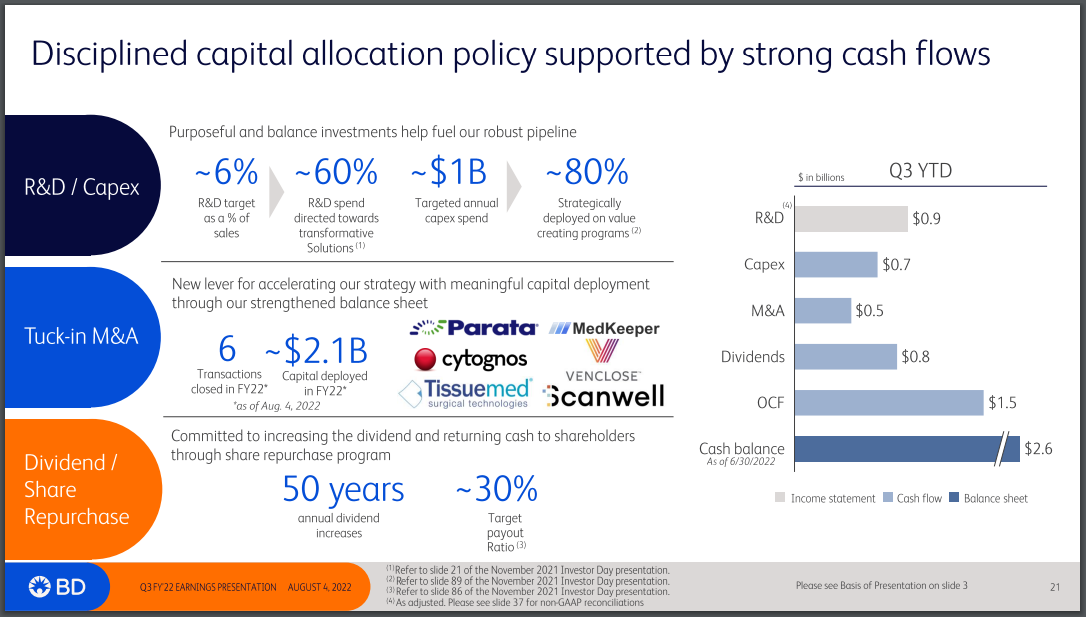Updated on October 12th, 2022 by Quinn Mohammed
Becton, Dickinson & Company (BDX) last increased its dividend for the 50th consecutive year. As a result, it has joined the exclusive list of Dividend Kings.
The Dividend Kings have raised their dividend payouts for at least 50 consecutive years. You can see all 45 Dividend Kings here.
You can download the full list of Dividend Kings, plus important financial metrics such as dividend yields and price-to-earnings ratios, by clicking on the link below:
BDX has maintained its long history of dividend increases thanks to a superior position in its industry. Its competitive advantages have fueled the company’s long-term growth.
As we see the potential for continued growth in the healthcare industry, BDX should keep increasing its dividend each year.
This article will discuss BDX’s business model, growth catalysts, and expected returns.
Business Overview
Becton, Dickinson & Company is a global leader in the medical supply industry.
The company was founded in 1897 and today operates in 190 countries, generating annual sales above $20 billion. Nearly half the company’s revenue comes from outside the U.S.
The company operates three segments. First, the Medical Division includes needles for drug delivery systems, and surgical blades.
The Life Sciences division provides products for the collection and transportation of diagnostic specimens. Lastly, the Intervention segment includes several of the products produced by what used to be Bard.
In all, BDX generates over $20 billion in annual revenue, nearly half of which is derived from outside the U.S.
Source: Investor Presentation
BD released earnings results for the third quarter of fiscal year 2022 on August 4th. Revenue grew 0.7% to $4.64 billion, beating estimates by $170 million.
Adjusted earnings-per-share of $2.66 compared unfavorably to adjusted earnings-per-share of $2.74 in the prior year but was $0.16 better than expected.
Medical segment sales grew 7.9% to $2.19 billion due to gains in medication delivery solutions, medical management solutions, and pharmaceutical systems.
Life Science was down 5.1% to $1.31 billion. Lastly, interventional segment revenue increased 7.9% to $1.14 billion.
U.S. revenue increased 9%, while international markets were down 1.9%.
The company updated guidance for fiscal year 2022, expecting adjusted earnings-per-share of $11.28 to $11.35, compared to $11.15 to $11.30 previously.
Growth Prospects
Healthcare stocks like BDX are typically purchased for their steady long-term growth. BDX is no exception; the company has grown earnings-per-share by 10% per year in the past decade.
Going forward, we expect the company to post a similar 10% annual EPS growth rate over the next five years. Broadly, this growth will be achieved thanks in large part to the aging U.S. population.
The U.S. is an aging population, meaning demand for healthcare supplies is only expected to rise going forward.
Total U.S. health expenditures are expected to total $4.46 trillion in 2022. Healthcare spending is expected to rise to $6.09 trillion in 2028, representing 5.3% annual growth.
This should be a broad tailwind that major healthcare manufacturers like BDX will benefit from.
BDX continues to invest heavily in product innovation, which is critical to the company meeting its long-term growth objectives.
Becton Dickinson did not repurchase shares so far in the nine months of fiscal 2022, whereas they repurchased $1.0 billion of common stock in the first nine months of fiscal 2021.

Source: Investor Presentation
The lack of repurchases in 2022 is likely due to the company’s $1.525 billion all-cash transaction to acquire Parata Systems.
This acquisition provides BDX with a portfolio of pharmacy automation solutions, which enable pharmacies to reduce costs, enhance patient safety and improve the patient experience.
The pharmacy automation market stands at $600 million and is expected to grow by roughly 10% annually to $1.5 billion in just the U.S in the next ten years.
Further acquisitions, and share repurchases over the long-term, are likely to lead to additional growth down the line.
Competitive Advantages & Recession Performance
Becton, Dickinson & Company has significant competitive advantages, including scale and a vast patent portfolio. These competitive advantages are due to high levels of investment spending.
BDX spends over $1 billion each year in research and development. This investment is critical to the company’s ability to generate long-term growth and maintain its industry leadership.
The company aims for a balanced capital allocation structure.

Source: Investor Presentation
It is clear that its R&D spending has paid off, as the company possesses over 29,000 active patents.
These competitive advantages provide the company with consistent growth, even during economic downturns.
Becton Dickinson steadily grew earnings during the Great Recession. Becton Dickinson’s earnings-per-share during the recession are as follows:
- 2007 earnings-per-share of $3.84
- 2008 earnings-per-share of $4.46 (16% increase)
- 2009 earnings-per-share of $4.95 (11% increase)
- 2010 earnings-per-share of $4.94 (0.2% decline)
Becton Dickinson generated double-digit earnings growth in 2008 and 2009, during the worst years of the recession. It took a small step back in 2010, but continued to grow in the years since, along with the economic recovery.
The ability to consistently grow earnings each year of the Great Recession, which was arguably the worst economic downturn in decades, is extremely impressive.
The company continued to perform well in 2020, when the coronavirus pandemic caused the U.S. economy to enter a recession. BDX remained highly profitable and was able to keep its dividend increase streak alive.
The reason for its recession resilience, is that health care patients need medical supplies regardless of the state of the broader economy. This keeps demand steady from year to year.
Valuation & Expected Returns
We expect BDX to generate earnings-per-share of $11.32 this year. As a result, the stock is currently trading at a price-to-earnings ratio of 19.7.
We consider 18.6 to be a fair earnings multiple for this stock, which matches the 10-year average multiple.
As a result, we view BDX stock as overvalued right now.
If the P/E multiple declines from 19.7 to 18.6 over the next five years, shareholder returns would be reduced by 1.1% per year.
However, dividends and earnings-per-share growth will boost shareholder returns. BDX shares currently yield 1.6%. And, we expect 10% annual EPS growth over the next five years.
Putting it all together, BDX stock is expected to generate annual returns of 10.3% over the next five years.
Final Thoughts
After raising its dividend in November 2021, BDX became a member of the exclusive Dividend Kings list.
It has maintained 50 consecutive years of dividend increases due to its top position in the healthcare industry.
And, thanks to the aging U.S. population, the company should benefit from this long-term growth catalyst. This should allow BDX to continue raising its dividend for many years to come.
Despite being a strong dividend growth stock, BDX is currently slightly overvalued. Still, we see the potential for annual returns just above 10%, making BDX stock a buy.
The following articles contain stocks with very long dividend or corporate histories, ripe for selection for dividend growth investors:
Thanks for reading this article. Please send any feedback, corrections, or questions to [email protected].















